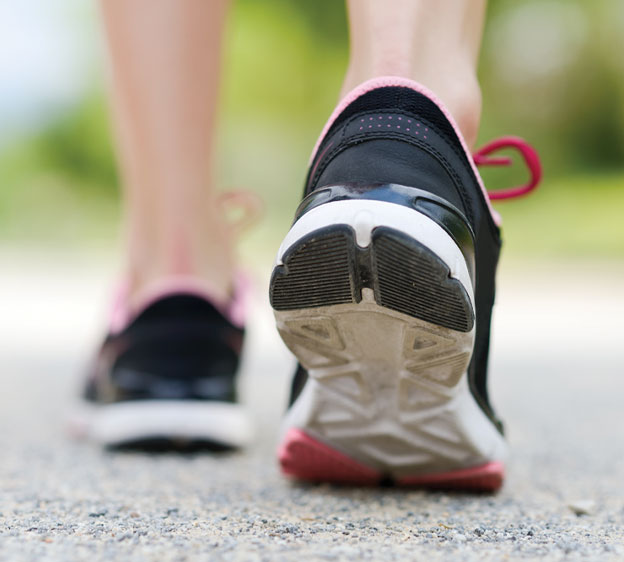Find the Best Shoes for Knee Pain: A Runner’s Guide
April 25, 2024Categories: Sports Medicine or Injuries

Whether you’re new to running or have logged thousands of miles, pain in the knee joints can slow you down. Finding the best shoes for knee pain relief can help you reach your health and running goals as painlessly as possible.
Although buying shoes sounds like a simple task, there are many factors to consider when searching for the best running shoes. The right shoes for you may not be the right shoes for another runner. Knowing what to look for and when to ask for expert advice can save you money, time and unnecessary knee pain.
How Shoes Can Cause Running-Related Knee Pain
Your feet are your base of balance and support. If you buy shoes without considering your foot shape or running routine, your joints may absorb too much impact or be out of alignment while running.
These issues can lead to ankle, hip, knee and back pain.
Read More: Exercise for Arthritis: Move More, Hurt Less
Understanding Shoe Design
All parts of a shoe are designed to protect or support a different part of the foot. Being knowledgeable about shoe design and what the various parts do can help you choose the best shoes for knee pain.
The Outsole
The outsole is the bottom of the shoe with the tread. Its job is to grip your running surface and protect your feet from debris.
“When researching shoes, consider where you’ll be running and look for shoes made for the terrain,” says Dr. Vandit Sardana, a board-certified, fellowship-trained orthopedic surgeon at Beaufort Memorial Orthopaedic Specialists. “Shoes made for trail running and shoes made for treadmill running need different outsole designs to maximize grip.”
The Midsole
The midsole sits on top of the outsole. It’s usually made of shock-absorbing foam. There may also be pockets of air or gel for extra cushioning.
The midsole’s design determines the shoe’s cushioning, height and stiffness. The ideal amount of each varies from person to person. Arch support is also commonly built into the midsole.
Additionally, the midsole determines the heel-to-toe drop, or the difference in height between the heel and the ball of the foot. When it comes to avoiding knee pain, the best shoes for most people have a heel-to-toe drop of 5 millimeters or less. This amount of drop reduces strain on the knees.
The Upper
The upper is the part of the shoe that surrounds the back, front, top and sides of the foot. It adds stability to the foot and helps prevent slipping. The three main parts of the upper are the vamp at the forefoot, the quarter at the midfoot and the counter, which wraps around the heel.
“The toe box is the space in the front of the shoe between the vamp and midsole where the ball of your foot and toes sit,” Dr. Sardana says. “Choose shoes that give you room to wiggle your toes.”
Read More: Aching for Knee Pain Relief? Try These Home Remedies
Choosing the Best Shoes for Knee Pain
The best shoes for you are the ones that allow your ankle and foot to move naturally while preventing the foot from rolling too far inward (overpronation) or outward (oversupination or underpronation).
People with low arches, or flat feet, often overpronate. They may benefit from a shoe with a rigid midsole, often called motion control or high-stability shoes.
Neutral and mild-stability shoes have moderate cushioning, a flexible midsole at the forefoot and more stability at the heel. This type of shoe is often a good choice for those with average arches and no significant pronation or supination issues.
Cushioning shoes are flexible and offer a thick layer of foam to reduce the impact of foot strikes. These may be a good choice for people with arthritis or those with high arches who underpronate.
Barefoot running shoes have little to no cushioning and zero heel-to-toe drop. They’re made for runners who strike the ground with their forefoot first instead of their heel. Talk with your health care provider before trying barefoot shoes if you have knee pain.
Finding the Right Fit
Shoe size can change with age. Measure both feet every time you get a new pair of running shoes. It’s normal to have feet that are different sizes. If there’s a significant size difference, consider buying two different sizes.
“Shoe sizes may vary slightly between manufacturers or styles of shoes,” Dr. Sardana says. “You may need to go up or down a size if you’re switching to a new brand or design.”
Shopping Tips to Find Your Best Shoes for Knee Pain
Follow these tips when shopping for running shoes to ensure you have the best fit:
- Choose a shoe based on the features and fit, not the advertising, colors or price.
- Consider shopping at a specialty store where team members understand how your foot health and running routine affect your shoe needs.
- Shop for shoes later in the day when feet tend to be swollen and wider.
- Take a quick run around the shop when trying on shoes.
- When shoe shopping, wear your running socks and bring any braces or orthotics you use.
For most people, running shoes need to be replaced every 400 to 600 miles. If you haven’t run that far but can see the midsole peeking through the outsole on the bottom of the shoe, it’s also time for a new pair.
When to Seek Support
In some cases, a new pair of shoes may not be enough to alleviate knee pain. In these cases, you may need custom orthotics, physical therapy or other treatments.
“If your pain continues after switching to a different shoe, make an appointment with an orthopedic specialist,” Dr. Sardana says. “They can help you determine the cause of your knee pain and talk with you about treatment options to get you back in the race.”
Tired of knee pain? Request an appointment with a Beaufort Memorial orthopedic specialist.

